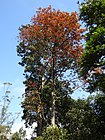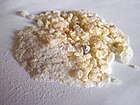Note: This is a project under development. The articles on this wiki are just being initiated and broadly incomplete. You can Help creating new pages.
Difference between revisions of "Canarium strictum - Mandadhupa"
(→Common names) |
|||
| (5 intermediate revisions by the same user not shown) | |||
| Line 2: | Line 2: | ||
'''Mandadhupa''' is a tall evergreen tree with pinnate leaves. It can found growing along rivers and streams in the [[western ghats]]. New leaves emerge bright red. Resin from the stem is harvested. | '''Mandadhupa''' is a tall evergreen tree with pinnate leaves. It can found growing along rivers and streams in the [[western ghats]]. New leaves emerge bright red. Resin from the stem is harvested. | ||
==Uses== | ==Uses== | ||
| − | {{Uses|Psoriasis}}, {{Uses|Skin diseases}}, {{Uses|Arthritis}}, {{Uses| | + | {{Uses|Psoriasis}}, {{Uses|Skin diseases}}, {{Uses|Arthritis}}, {{Uses|Fever}}, {{Uses|Epilepsy}}, {{Uses|Asthma}} |
<ref name="Uses"/> | <ref name="Uses"/> | ||
| Line 10: | Line 10: | ||
==Common names== | ==Common names== | ||
| − | {{Common names|kn= | + | {{Common names|kn=Haale maddu, Haalu maddi|ml=Karunkungiliam, Kunthirikkapayin|sa=Mandadhupa, Raladhupa|ta=Kakanemi, Karukunkiliyam, Kungiliam, Kunturukkam|te=Nalla-rojan, Nallarojanamu, Nallarojen|hi=Kala Dammar|en=}} |
<ref name="Common names"/> | <ref name="Common names"/> | ||
| Line 34: | Line 34: | ||
==Identification== | ==Identification== | ||
===Leaf=== | ===Leaf=== | ||
| − | {{Leaf|Pinnate| | + | {{Leaf|Pinnate|Alternate|Leaves imparipinnate, alternate; stipules obscure; leaflets 7-11, opposite.}}<ref name="Leaf"/> |
===Flower=== | ===Flower=== | ||
| − | {{Flower|Polygamous| | + | {{Flower|Polygamous|Axillary panicles|Pale yellow||Male flowers; pedicels short; calyx tube campanulate, pubescent without, 5 mm.}} |
===Fruit=== | ===Fruit=== | ||
| − | {{Fruit|A drupe|3.5 x 1.5 cm| | + | {{Fruit|A drupe|3.5 x 1.5 cm|Ellipsoid, dark blue, 1-3-celled; seeds 1-3.||}} |
===Other features=== | ===Other features=== | ||
| Line 73: | Line 73: | ||
<references> | <references> | ||
| − | <ref name="Uses">[http://www.ayurvedavignan.com/2013/04/canarium-strictum.html | + | <ref name="Uses">[http://www.ayurvedavignan.com/2013/04/canarium-strictum.html Uses]</ref> |
| − | <ref name="Leaf">[http://FLOWERING PLANTS OF KERALA VER.2, N. Sasidharan | + | <ref name="Leaf">[http://FLOWERING PLANTS OF KERALA VER.2, N. Sasidharan BOTANIC DESCRIPTION]</ref> |
| − | <ref name="Common names">[http://envis.frlht.org/bot_search | + | <ref name="Common names">[http://envis.frlht.org/bot_search Vernacular names]</ref> |
| − | <ref name="Cultivation details">[http://www.ijcs.uaic.ro/pub/IJCS-12-23-Meena.pdf | + | <ref name="Cultivation details">[http://www.ijcs.uaic.ro/pub/IJCS-12-23-Meena.pdf Cultivation details]</ref> |
| Line 84: | Line 84: | ||
* [http://tropical.theferns.info/viewtropical.php?id=Canarium+strictum The ferns.info] | * [http://tropical.theferns.info/viewtropical.php?id=Canarium+strictum The ferns.info] | ||
* [https://www.researchgate.net/publication/264542820_Pharmacognostical_studies_on_stem_bark_of_Canarium_strictum_Roxb_INTRODUCTION Canarium strictum on researchgate.net] | * [https://www.researchgate.net/publication/264542820_Pharmacognostical_studies_on_stem_bark_of_Canarium_strictum_Roxb_INTRODUCTION Canarium strictum on researchgate.net] | ||
| − | + | ||
[[Category:Herbs]] | [[Category:Herbs]] | ||
[[Category:Plants of western ghats]], [[Category:Tree]] | [[Category:Plants of western ghats]], [[Category:Tree]] | ||
[[Category:Burseraceae]] | [[Category:Burseraceae]] | ||
Latest revision as of 11:34, 15 September 2020
Mandadhupa is a tall evergreen tree with pinnate leaves. It can found growing along rivers and streams in the western ghats. New leaves emerge bright red. Resin from the stem is harvested.
Contents
- 1 Uses
- 2 Parts Used
- 3 Chemical Composition
- 4 Common names
- 5 Properties
- 6 Habit
- 7 Identification
- 8 List of Ayurvedic medicine in which the herb is used
- 9 Where to get the saplings
- 10 Mode of Propagation
- 11 How to plant/cultivate
- 12 Commonly seen growing in areas
- 13 Photo Gallery
- 14 References
- 15 External Links
Uses
Psoriasis, Skin diseases, Arthritis, Fever, Epilepsy, Asthma [1]
Parts Used
Chemical Composition
Common names
| Language | Common name |
|---|---|
| Kannada | Haale maddu, Haalu maddi |
| Hindi | Kala Dammar |
| Malayalam | Karunkungiliam, Kunthirikkapayin |
| Tamil | Kakanemi, Karukunkiliyam, Kungiliam, Kunturukkam |
| Telugu | Nalla-rojan, Nallarojanamu, Nallarojen |
| Marathi | NA |
| Gujarathi | NA |
| Punjabi | NA |
| Kashmiri | NA |
| Sanskrit | Mandadhupa, Raladhupa |
| English |
Properties
Reference: Dravya - Substance, Rasa - Taste, Guna - Qualities, Veerya - Potency, Vipaka - Post-digesion effect, Karma - Pharmacological activity, Prabhava - Therepeutics.
Dravya
Rasa
Tikta (Bitter), Katu (Pungent), Kashaya (Astringent)
Guna
Laghu (Light)
Veerya
Ushna (Hot)
Vipaka
Karma
Kapha, Vata
Prabhava
Habit
Identification
Leaf
| Kind | Shape | Feature |
|---|---|---|
| Pinnate | Alternate | Leaves imparipinnate, alternate; stipules obscure; leaflets 7-11, opposite. |
Flower
| Type | Size | Color and composition | Stamen | More information |
|---|---|---|---|---|
| Polygamous | Axillary panicles | Pale yellow | Male flowers; pedicels short; calyx tube campanulate, pubescent without, 5 mm. |
Fruit
| Type | Size | Mass | Appearance | Seeds | More information |
|---|---|---|---|---|---|
| A drupe | 3.5 x 1.5 cm | Ellipsoid, dark blue, 1-3-celled; seeds 1-3. | {{{6}}} |
Other features
List of Ayurvedic medicine in which the herb is used
Where to get the saplings
Mode of Propagation
How to plant/cultivate
Seeds are soaked in water for 24 hours and sowed in shaded beds. [4]
Commonly seen growing in areas
Tropical area, Evergreen forest
Photo Gallery
References
External Links
- Ayurvedic Herbs known to be helpful to treat Psoriasis
- Ayurvedic Herbs known to be helpful to treat Skin diseases
- Ayurvedic Herbs known to be helpful to treat Arthritis
- Ayurvedic Herbs known to be helpful to treat Fever
- Ayurvedic Herbs known to be helpful to treat Epilepsy
- Ayurvedic Herbs known to be helpful to treat Asthma
- Herbs with Resin used in medicine
- Herbs with common name in Kannada
- Herbs with common name in Hindi
- Herbs with common name in Malayalam
- Herbs with common name in Tamil
- Herbs with common name in Telugu
- Herbs with common name in Sanskrit
- Habit - tree
- Index of Plants which can be propagated by Seeds
- Herbs that are commonly seen in the region of Tropical area
- Herbs that are commonly seen in the region of Evergreen forest
- Herbs
- Plants of western ghats
- Tree
- Burseraceae






